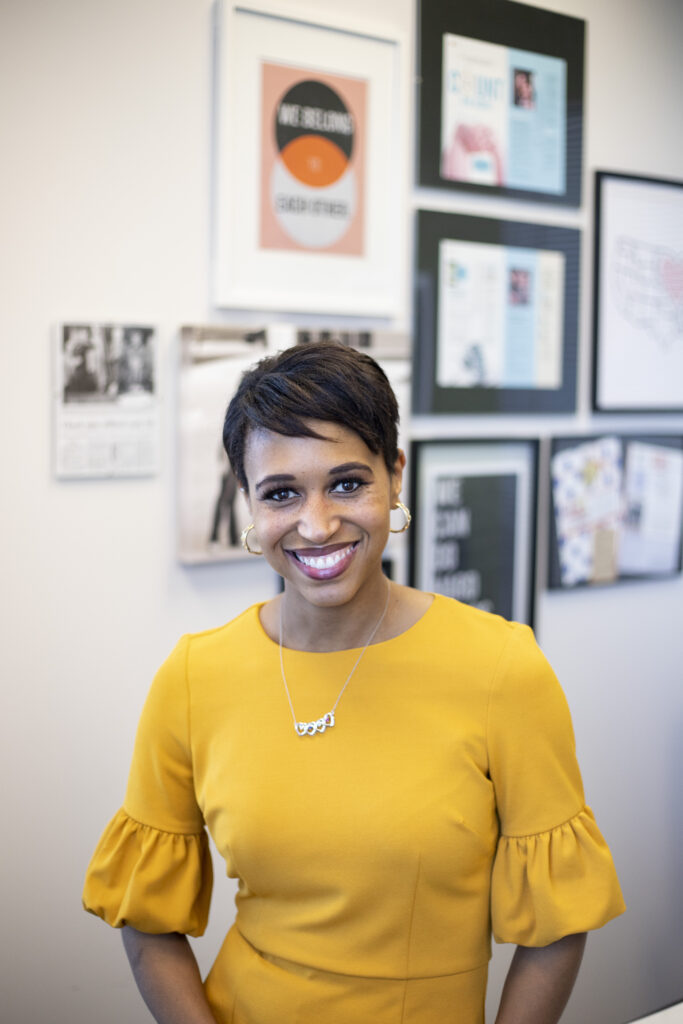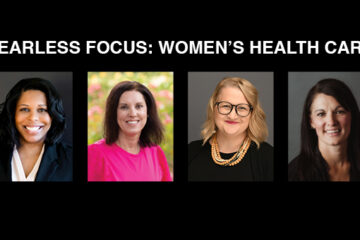By Emily Kestel, Fearless editor

Age: 32
Hometown: Clive
Family: Husband, Ra Shaan; children Bishop, age 3, and Jaira, 5 months
Education: University of Northwestern-St. Paul – bachelor’s in electronic media communications
Hobbies: Shopping, watching reality TV
Contact: long.jodi@healthybirthday.org
Three days after giving birth to her daughter, Jaira, in July 2022, Jodi Long was diagnosed with postpartum preeclampsia, a rare and serious condition of having high blood pressure after pregnancy. At its highest, her blood pressure was 198/100. (A normal blood pressure reading is 120/80.)
The 3½-day stay in the hospital, and reckoning with the notion that she could have died had she not been seen by medical professionals, solidified her decision to leave the news industry and begin working in the health equity field.
“I left the news industry to tell the story about how the state of maternal health of women is in crisis, and there’s something that we can do about it,” Long said. “I’ve always been passionate about the work and had been involved with the organization in a volunteer capacity for a few years. Now it hits close to home.”
Long has been in her position at Healthy Birth Day Inc. since October. We caught up with her to talk about her decision to leave WHO 13 and her goals for her position.
The following interview has been edited and condensed for clarity.
You spent 10 years at WHO 13. Tell me about your decision to step away from the news industry and pivot to something different.
I never had thought that I was going to leave television. I wasn’t even looking for this job. I was approached by [Healthy Birth Day CEO] Emily Price, who said, “We have to grow our health equity team, because equity is at the center of our organization. We’re creating a health equity director position. Would this be something that you would consider?” I had been a member of the influencer advisory board with Count the Kicks for about a year, and I had done stories on Count the Kicks throughout my time in journalism. I had been asked to host and emcee events for the organization, so Emily and I already had that relationship.
It was wild, because I had been thinking about how I was going to navigate the 1:45 a.m. wake-up call every single day with a toddler, a newborn, and my husband, who works 12-hour days, six days a week. When I was approached about it, I really started thinking, “Oh, yeah, maybe this is the time for me to leave.” That was a big decision, to leave my dream job.
It’s hard to avoid being on display [working in TV news]. People think that they know you because they see you every day from 4:30 a.m. until 7 a.m., and so you’re just kind of thrust into the public eye. And then when you exit, people want to know how you’re doing and what you’re doing. I told my husband when I was considering leaving, “I’m just going to be regular now.” I’m adjusting to life being out of a spotlight. I’m working for a cause that’s bigger than myself, which is really cool. I’m part of a team. No one person is standing out. Everything that each one of us is doing is for the collective good of moving the needle.
What do your day-to-day responsibilities look like at Healthy Birth Day?
I oversee the health equity coordinator and her duties, but in essence, our job is to look at our work within the organization through an equitable lens and specifically address the racial disparities. African American women are 2½ times more likely to endure a stillbirth, so we have a big focus on helping out those who fit that demographic. The numbers for others aren’t looking good, either. Indigenous women, that number is not good right now. Hispanic women, that’s still at a disproportionate rate compared to white women. There’s a lot of work to be done, and our focus is specifically in that area of work. We have a laser focus to help get into those groups, and learn what they need to help educate them on how to [avoid] a preventable stillbirth.
We’re contacting groups all across the country. So, for example, I’ll reach out to somebody who’s partnered with us in the state of Nevada and say, “How can I help? What are the ZIP codes that you guys are most focused on in terms of, this area has little access to health care or stillbirth rates are high in this county?” I kind of tap into that.
I’m looking at data from the states as well, to see where they’re at and where we can help out with. I’m meeting with my team on ways to get further into these communities and reach more people. Strategy is kind of a big thing for us, because what works in one state might not work in another state. By the beginning of 2023, 23 states will have our free materials in them.
We do a lot of presentations virtually through webinars. It’s a chance for us to talk with a group of people, who might be providers, labor and delivery nurses, doulas, or moms. We talk about who we are, that we’re research- and evidence-based, how the app works, and what we’re doing to move the needle in terms of reaching marginalized women in groups.
What are your goals for your position?
Our main goal is to make it common practice that women are tracking their fetal movements and knowing how to do that and empowering them to speak up when they notice a change. So part of that is getting these materials into their hands so that they know how to do that.
Another big goal is to just keep the stillbirth rates trending in the right direction. But we want to better reach those groups and build lasting relationships with them.
Internally, we want to make our organization more diverse, and not just in terms of color. I’m tasked with that as the health equity director. Outward-facing, our goal is to make sure that these groups aren’t being left behind and that we are educating them as well as getting through to providers as to why this is important.
Not every state has Count the Kicks materials that are given to them for free. We have to partner with them through the state’s health organization, or through a [managed care organization] to get free materials. Iowa is where we were founded and created, so materials are free here. And that’s thanks to our partnership with the Iowa Department of Health and Human Services. On a smaller scale, we have community-based groups and other nonprofits like United Way helping us out. We have the Iowa Black Doula Collective that are helping us spread the word. We do a lot of work with MercyOne, they sponsor a lot of events for us and give us money to help run our organization. UnityPoint is big in terms of our Every Kick Counts program as well.
As you mentioned earlier, Black birthing people in particular face significant disparities when it comes to maternal health and birth outcomes. Talk about that disparity a bit and why we should care about it.
Every year, about 7,000 Black babies are born still. Right now, 1 in 96 Black pregnancies end in stillbirth. It’s alarming. The reasoning why this is happening is because of a number of things. There’s the epigenetics, which is essentially the genes of a woman changing due to the toxic stress and environment that they’re in. Where you live and the environment that you’re in is huge. There is that structural racism within the medical field that is creating a big barrier for women to have healthy outcomes in their pregnancies and for themselves as well. I always point back to Serena Williams, who is the GOAT and had the best-of-the-best care, and even her life was put at risk based on doctors just simply not believing her.
Why are we allowing this to happen? If this was a white woman dying, we’d be like, “Oh, my gosh, we have to do something.” Black women are consistently not listened to, or not given equal level of care or the consistent care that they need. That’s what has to change. There should be no reason why this is happening in a developed country like the United States, period.
What can be done to address these disparities and further the mission? What are some actual tangible things that need to happen?
We have to get through to doctors to address the implicit bias in the health care and hospital systems, so that they can look at a patient holistically and not through the lens of “I’m not going to listen to this person for one reason or another.”
What we are finding out is that doctors feel like if we educate moms on fetal movement, they might get too anxious about it. They might be calling every time they feel like their baby is acting differently. But it’s your job to make sure that women are OK and deliver their babies safely. Women are not a burden when they have a concern. And so that’s huge in terms of getting through to the doctors that this matters. I also think too, and this is not something that’s going to happen overnight, but to have more representation in the birthing field, in the health care system who better understand this and more allyship in this area.
Those are the big long-term goals, but I would say in the short term, actionable steps that can be taken right away and be put to use is to also reach out to Congress. We have pieces of legislation that are awaiting full approval from Congress that would add stillbirth prevention to Title V of the Social Security Act.
The Maternal and Child Health Stillbirth Prevention Act would recognize that the stillbirth and the disparity of those impacted by it requires further research, support and prevention programming. It also calls for evidence-based programs and activities and outcome research to reduce the incidence of stillbirth, including tracking and awareness of fetal movement. That is honestly a small action step. Reach out to your congressperson and say, “Support this.” It’s a nonpartisan issue. It’s really not asking for much. But it is taking an army to get this work recognized, believed and put into action.
Part of your decision to move from the journalism industry to this position was to focus on storytelling on this one particular issue. Why is storytelling so powerful in this field?
It’s easy to get caught up in the numbers, that 23,500 babies are born still each year. But when you see the family that has a picture of their child born still in the bow that they had bought for them to take them home in, and you hear that family’s firsthand account of how this happened and the impact it’s left on their lives forever, I think is what gets down to the heart of people to want there to be change. It’s so important to hear these stories, to realize why this is such a big deal. And there needs to be something done about it. I mean, who doesn’t love a good story? People are captivated by stories. As sad as some of them are, they’re really encouraging and they’re really empowering. And we are finding that when we share these stories, they’re turning the pain into purpose and into power.
You mentioned your experience of having postpartum preeclampsia a little bit earlier, but I’d like to give you the opportunity to expand on your full story of that.
It was really traumatic. I was induced at 39 weeks for having slightly elevated blood pressure. And I’m a woman of faith, and I believe that God’s hand was in every step of this, because as I researched this, the Preeclampsia Foundation recently pushed to have the threshold for blood pressure lowered.
The labor and delivery went fine. Blood pressure was fine. Baby was great. I went home a few days later and the doctor’s office wanted me to come back just to make sure everything was OK.
I remember taking a picture of myself in the mirror and sending it to my husband, and I was like, “Already back in my regular jeans, feeling cute. Off to my doctor’s appointment, I’ll let you know how it goes.” I got there, and they took my blood pressure several times before taking it manually.
The tone of the room got serious. It shifted. I remember the doctor came in and he was wearing blue funky modern glasses, and he’s like, “This is serious. You’re on a stroke level. You could have a seizure any moment. You’re gonna be here for a while until we get this figured out.” I was like, “But I feel fine.” He asked if I had any blurred vision or severe sudden headaches. I said no, and he said, “You’re the scariest patient, because you’re like a ticking time bomb. Something catastrophic would have happened to you if you did not come here today. You can’t walk around with blood pressure levels like these and have something not happen to you.”
It was the worst thing because it was like I was fine, and then I wasn’t.
They immediately put me on a medicine called magnesium sulfate, which is an anti-seizure medicine that relaxes your brain from constricting on the blood vessels that are already working really hard to pump the blood. The best way to describe it is having your head underwater. You could hear things, but were out of it. You’re bedridden. My eyes were all bloodshot. I was just sitting there and I had my baby with me who’s five days old. My husband was there. I had so much medicine in me. We finally got out of there three days later. I left the hospital on eight blood pressure pills a day.
I was not better by my six-week postpartum checkup. I was right back up to seven pills a day. I went to get a second opinion from a cardiologist, and I was so thankful that this cardiologist ended up being a person of color. He was like, “You are responding differently to certain medications based on your makeup. This could be a chronic thing, you could just have high blood pressure, but I don’t think you will forever. We just need to get you on the right dosage and the type of medicine that you need.” Already things are trending in the right direction. I’m having blood pressure readings back in the 120s again, but I’m still on four pills.
Five months out, it’s still emotional for me to talk about.
Is there anything else you’d like people to know about the work that you’re doing or the position that you’re in?
Since I am the health equity director, it’s not like we are part of the movement of organizations starting to get an equity person on board, or crafting DEI statements just for DEI’s sake. Our goal is to reach all moms, and we know that some moms need to be reached out to even a little bit more so that they have better outcomes. That’s just who we are. It wasn’t like, “Oh, shoot, we need to start reaching the Black population or the Hispanic population.” It’s always been like, “We’re reaching everybody, and we realize that some areas need a lot more work. So we’re going to hire a team to make sure the extra effort is being put towards that group so that everybody’s equal.” This is not a “We’re just hiring a Black person to fill this Black role.”
Be on the lookout for us. Our future is bright and we have a really big task. We are the only organization specifically and solely focused on stillbirth prevention in the country, and it’s in the heart of Iowa. How random and how cool is that?


